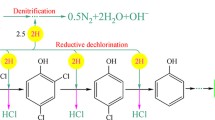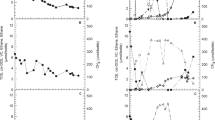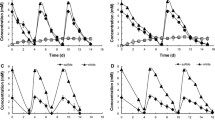Abstract
The inhibition of nitrous oxide (N2O) reduction by acetylene (C2H2) in saltmarsh sediment was temporary; we investigated this phenomenon and possible causes. The reduction of N2O in the presence of C2H2 was biological. N2O consumption in the presence of C2H2 began when nitrate concentration became very low. The time course of N2O consumption after periods of N2O accumulation was unaffected by initial nitrate concentrations between 16 and 200μM, or C2H2 concentrations between 10 and 100% of the gas phase. Sulfide had no effect on the kinetics of N2O reduction in the presence of C2H2. In more dilute slurries of saltmarsh sediments and in estuarine sediment, N2O persisted in the presence of C2H2 unless sufficient organic carbon was added to deplete nitrate. In saltmarsh sediments, the rate of N2O consumption in the presence of C2H2 was not changed by preincubation with C2H2. Initial positive rates of N2O production in the presence of C2H2 occurred only when the block was apparently effective (i.e., at nitrate concentrations greater than about 5–10μM) and appeared to represent a valid estimate of denitrification. Conversely, and in agreement with previous studies, concentrations of NO3 − below these levels resulted in reduced efficiency of C2H2 blockage of N2O reductase.
Similar content being viewed by others
References
Adkins AM, Knowles R (1984) Reduction of nitrous oxide by a soilCytophaga in the presence of acetylene and sulfide. FEMS Microbiol Lett 23:171–174
Adkins AM, Knowles R (1986) Denitrification byCytophaga johnsonae strains and by a gliding bacterium able to reduce nitrous oxide in the presence of acetylene and sulfide. Can J Microbiol 32:421–424
Andersen JM (1974) Nitrogen and phosphorus budgets and the role of sediments in six shallow Danish lakes. Arch Hydrobiol 74:528–550
Balderston WL, Sherr B, Payne WJ (1976) Blockage by acetylene of nitrous oxide reduction inPseudomonas perfectomarinus. Appl Environ Microbiol 31:504–508
Blackmer AM, Bremner JM (1978) Inhibitory effect of nitrate on reduction of N2O to N2 by soil microorganisms. Soil Biol Biochem 10:187–191
Buresh RJ, Patrick WH (1981) Nitrate reduction to ammonium and organic nitrogen in an estuarine sediment. Soil Biol Biochem 13:279–283
Capone DG, Taylor BF (1980) Microbial nitrogen cycling in a seagrass community. In: Kennedy VS (ed) Estuarine perspectives. Academic Press, New York, pp 153–161
Chan YK, Knowles R (1979) Measurement of denitrification in two freshwater sediments by an in situ acetylene inhibition method. Appl Environ Microbiol 37:1067–1072
Evans DG, Beauchamp E, Trevors JT (1985) Sulfide alleviation of the acetylene inhibition of nitrous oxide reduction in soil. Appl Environ Microbiol 49:217–220
Gersberg R, Krohn R, Peck N, Goldman CR (1976) Dentrification studies with13N-labeled nitrate. Science 191:1229–1231
Hattori A (1983) Denitrification and dissimilatory nitrate NO3 − and SO4 2− reduction in estuarine sediment: The significance of an NO3 − reduction maximum in spring. Mar Ecol Prog Ser 24:65–74
Jenkins MC, Kemp WM (1984) The coupling of nitrification and denitrification in two estuarine sediments. Limnol Oceanogr 29:609–619
Jorgensen BB, Sorensen J (1985) Seasonal cycles of O2, NO3 −, and SO4 2− reduction in estuarine sediments: The significance of an NO3 − reduction maximum in spring. Mar Ecol Prog Ser 24:65–74
Kaplan W, Valiela I, Teal JM (1979) Denitrification in a salt marsh ecosystem. Limnol Oceanogr 24:726–734
Kaspar H (1982) Denitrification in marine sediment: Measurement of capacity and estimate of in situ rate. Appl Environ Microbiol 43:522–527
Kaspar HF, Tiedje JM, Firestone RB (1981) Denitrification and dissimilatory nitrate reduction to ammonium in digested sludge. Can J Microbiol 27:878–885
King D, Nedwell DB (1985) The influence of nitrate concentration upon the end-products of nitrate dissimilation by bacteria in anaerobic salt marsh sediment. FEMS Microbiol Ecol 31:23–28
Koike I, Hattori A (1978) Denitrification and ammonium formation in anaerobic coastal sediments. Appl Environ Microbiol 35:278–282
Messer J, Brezonik PL (1983) Comparison of denitrification rate estimation techniques in a large, shallow lake. Water Res 17:631–640
Miller LG, Oremland RS, Paulsen S (1986) Measurement of nitrous oxide reductase activity in aquatic sediments. Appl Environ Microbiol 51:18–24
Nishio T, Koike I, Hattori A (1982) Denitrification, nitrate reduction, and oxygen consumption in coastal and estuarine sediments. Appl Environ Microbiol 43:648–653
Oremland RS, Umberger C, Culbertson CW, Smith RL (1984) Denitrification in San Francisco Bay intertidal sediments. Appl Environ Microbiol 47:1106–1112
Oremland RS, Capone DG (1988) Use of specific inhibitors in microbial ecological and biogeochemical studies. In: Marshall KC (ed) Advances in microbial ecology, vol. 10. Plenum Press, New York, pp 285–383
Pearsall KA, Bonner FT (1980) Analysis of dinitrogen-nitrogen oxide mixtures employing direct vacuum line-gas chromatograph injection. J Chrom 200:224–227
Seitzinger S, Nixon S, Pilson MEQ, Burke S (1980) Denitrification and N2O production in near-shore marine sediments. Geochim Cosmochim Acta 44:1853–1860
Slater J, Capone DG (1984) Effects of metals on nitrogen fixation and denitrification in slurries of anoxic saltmarsh sediment. Mar Ecol Prog Ser 18:89–95
Slater JM, Capone DG (1987) Denitrification in aquifer soils and nearshore marine sediments influenced by groundwater nitrate. Appl Environ Microbiol 53:1292–1297
Smith MS, Firestone MK, Tiedje JM (1978) The acetylene inhibition method for short-term measurement of soil denitrification and its evaluation using nitrogen-13. Soil Sci Am J 42:611–616
Sorensen J (1978) Denitrification rates in a marine sediment as measured by the acetylene inhibition technique. Appl Environ Microbiol 36:139–143
Sorensen J (1978) Capacity for denitrification and reduction of nitrate to ammonium in a coastal marine sediment. Appl Environ Microbiol 35:301–305
Sorensen J, Tiedje JM, Firestone RB (1980) Inhibition by sulfide of nitric and nitrous oxide reduction by denitrifyingPseudomonas fluorescens. Appl Environ Microbiol 39:105–108
Sorensen J, Rasmussen L, Koike I (1987) Micromolar sulfide concentrations alleviate acetylene blockage of nitrous oxide reduction by denitrifyingPseudomonas fluorescens. Can J Microbiol 33:1001–1005
Strickland JDH, Parsons TRA (1972) A practical handbook of seawater analysis. 2nd ed. Fisheries Research Board of Canada, Bull 167, Ottawa
Tam T-Y, Knowles R (1979) Effects of sulfide and acetylene on nitrous oxide reduction by soil and byPseudomonas aeruginosa. Can J Microbiol 25:1133–1138
Vanderboght J-P, Billen G (1975) Vertical distribution of nitrate concentration in interstitial water of marine sediments with nitrification and denitrification. Limnol Oceanogr 20:953–961
Van Raalte CD, Patriquin DG (1979) Use of the “acetylene blockage” technique for assaying denitrification in a salt marsh. Mar Biol 52:315–320
Whitledge TE, Malloy SC, Patton CJ, Wirick CD (1981) Automated nutrient analyses in seawater (Brookhaven National Laboratory 515398, UC-11, Environmental Control Technology and Earth Sciences-TIC-4500), National Technical Information Service
Yeomans JC, Beauchamp EG (1978) Limited inhibition of nitrous oxide reduction in soil in the presence of acetylene. Soil Biol Biochem 10:517–519
Yoshinari Y, Knowles R (1976) Acetylene inhibition of nitrous oxide reduction by denitrifying bacteria. Biochem Biophys Res Comm 6:705–710
Yoshinari T, Hynes R, Knowles R (1977) Acetylene inhibition of nitrous oxide reduction and measurement of denitrification and nitrogen fixation in soil. Soil Biol Biochem 9:177–183
Author information
Authors and Affiliations
Rights and permissions
About this article
Cite this article
Slater, J.M., Capone, D.G. Nitrate requirement for acetylene inhibition of nitrous oxide reduction in marine sediments. Microb Ecol 17, 143–157 (1989). https://doi.org/10.1007/BF02011849
Issue Date:
DOI: https://doi.org/10.1007/BF02011849




